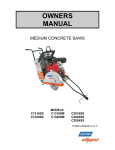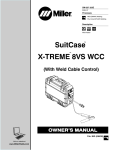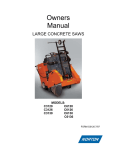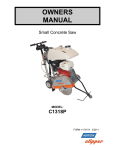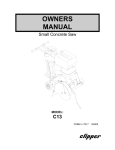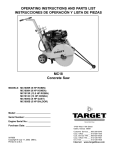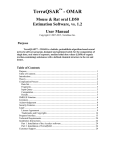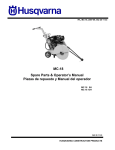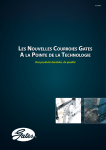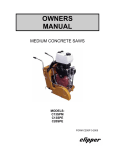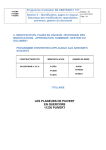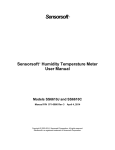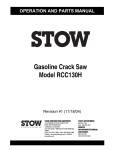Download Clipper C1320SS Owner`s manual
Transcript
OWNERS MANUAL MEDIUM CONCRETE SAWS MODEL: C1320P FORM C1320P rev 9-2010 WARRANTY Norton warrants all products manufactured by it against defects in workmanship or materials for a period of one (1) year from the date of shipment to the customer. The responsibility of Norton under this warranty is limited to replacement or repair of defective parts at Norton's Gainesville, Georgia factory, or at a point designated by it, of such part as shall appear to us upon inspection at such point, to have been defective in material or workmanship, with expense for transportation borne by the customer. In no event shall Norton be liable for consequential or incidental damages arising out of the failure of any product to operate properly. Integral units such as gasoline engines, electric motors, batteries, tires, transmissions, etc., are excluded from this warranty and are subject to the prime manufacturer's warranty. This warranty is in lieu of all other warranties, expressed or implied, and all such other warranties are hereby disclaimed. Important: Before placing equipment in operation, record the following information. MODEL:_________ SERIAL NO.___________ PURCHASE FROM: _____________________ ADDRESS: ____________________________ CITY_______ STATE ______ ZIP ________ TELEPHONE NO. ______________________ Before using this equipment, make sure that any person using it reads and understands the instructions in this owner’s manual. 2 Table of Contents CONTENTS Warranty Information I. Preparation A. Safety Precautions B. Assembly C. Concrete Saw Specifications II. Operation A. Blade Installation B. Changing the Blade Side C. Engine Operation D. Starting The Engine E. Water Supply F. Controls G. Operating The Saw H. Cutting Technique I. Lead-Off Adjustment III. Maintenance A. Engine Engine Warranty B. Bearings C. V-Belts D. Depth Control G. Electrical Diagram 13HP Manual Start IV. Parts List Section A. Ordering Information Common Replacement Parts B. Assembly Drawings/Service Parts Listing Frame Common Group Raise Axle Group Blade Shaft and Engine Group Blade Guard and Water System Group Controls and Console Group Depth Adjustment Group Optional Water Tank Group Contact Information PAGE 2 4-6 7 8 9-11 12-1412-14 14-16 16 17-18 18-19 19-20 20 21-22 23 24 25-26 26-27 28 29 29 30-43 30-31 32-33 34-35 36-37 38-39 40-41 42-43 44 Read Owners Manual Before Use Safety Alert Symbol: Information Following This Symbol Is Very Important. 3 I. PREPARATION A. Safety Precautions Important! The following safety precautions must always be observed. Hazard Symbols Fuel (gasoline) is extremely flammable and its vapors can explode if ignited. Store gasoline only in approved containers, in well-ventilated, unoccupied approved areas, and away from sparks or flames. Do not fill the fuel tank while the engine is hot or running. Do not start the engine near spilled fuel. Never use the fuel as a cleaning agent Engine components can get extremely hot from operation. To prevent burns, do not touch the engine or related parts while the engine is running or immediately after it is turned off. Never operate the engine with any heat shields or guards removed. Keep all guards in place when operating any piece of equipment Keep hands, feet, hair, and clothing away from all rotating parts Lethal Exhaust Gas: use only in well ventilated areas. Engine exhaust gases contain poisonous carbon monoxide, which is odorless, colorless, and can cause death if inhaled. Avoid inhaling exhaust fumes, and never run the engine in a closed building or confined area. Never tamper with the governor components of settings to increase the maximum speed. Severe personal injury and damage to the engine or equipment can result if operated at speed above maximum. Always obey the maximum speed rating of blade. DO NOT LIFT THE SAW BY THE HANDLE BARS 4 Dust and Silica Warning Grinding/cutting/drilling of masonry, concrete, metal and other materials can generate dust, mists and fumes containing chemicals known to cause serious or fatal injury or illness, such as respiratory disease, cancer, birth defects or other reproductive harm. If you are unfamiliar with the risks associated with the particular process and/or material being cut or the composition of the tool being used, review the material safety data sheet and/or consult your employer, the material manufacturer/supplier, governmental agencies such as OSHA and NIOSH and other sources on hazardous materials and make certain to comply with all product warnings and instructions for the safe and effective use of the material being cut. California and some other authorities, for instance, have published lists of substances known to cause cancer, reproductive toxicity, or other harmful effects. Control dust, mist and fumes at the source where possible. In this regard use good work practices and follow the recommendations of the manufacturer/supplier, OSHA/NIOSH, and occupational and trade associations. Water should be used for dust suppression when wet cutting is feasible. When the hazards from inhalation of dust, mists and fumes cannot be eliminated through engineering controls such as vacuum and/or water mist, the operator and any bystanders should always wear a respirator approved by NIOSH/MSHA for the material being cut. Use Approved: Eye Protection Hearing Protection Respiratory Protection 5 Head Protection 1. Before mounting any blade on the saw, the blade should be inspected for any damage which might have occurred during shipment, handling or previous use. 2. The blade collars and arbors should be cleaned and examined for damage before mounting the blade. 3. The blade must be properly fitted over the arbor with the drive pin on the outside collar projecting through the drive pin hole on the blade and inside collar. 4. The blade shaft nut, which is a left hand thread nut, must be tightened securely against the outside blade shaft collar. 5. The blade must be operated within the specified maximum operating speed listed on the blade. 6. Turn water control valve to full to provide adequate coolant (5 to 8 gallons per minute) for diamond blades and wet cutting abrasive blades. Insufficient coolant could result in severe blade breakage or diamond segment separation. 7. The blade guard must be in place with the nose guard down and locked when the saw is running. 8. The operator should wear safety glasses and any other appropriate safety equipment. 9. When starting the saw, the operator should stand away and to the side of the blade. 10. If for any reason the saw should stall in the cut, raise the blade out of the cut. Check the outside blade shaft collar and nut for tightness. Inspect the blade for damage before restarting the saw. User caution when resuming a cut. Be certain that the blade is in alignment with the previous cut. 11. During cutting operations, do not exert excess side pressure on the handles as a method of steering. Do not force the blade into the cut by lowering the blade too fast or by pushing the saw too fast. You Are Responsible For Your Safety!!! 6 I. PREPARATION B. Assembly The C1320P push concrete saws are shipped completely assembled and ready for use except for diamond blade, gasoline, oil, and handle bar. Inspect the saw for shipping damage. If any damage is found, contact the shipper immediately and file a freight claim. Norton Clipper is not responsible for any freight-related damages. Remove the saw from the pallet. Reverse the position of the handlebars so that the handle bar sticks out towards the operator. Adjust the handlebars to the desired height. Attach the handlebars to the saw with the supplied hardware. For electric start models fill and check the electrolyte level and charge the battery. Read and understand the remaining sections of this Owners Manual. NOTE: Do not install the blade until it is time to use the saw. ANSI regulations prohibit the transportation of any concrete saw with the blade installed. DO NOT LIFT THE SAW BY THE HANDLE BARS 7 C. C1320P Concrete Saw Specifications Dimensions/Weight Length (Transport) Width Height Weights Engine Engine Mfg. Model Spec No. Engine Type Horse Power* Max Torque* Cooling System Oil Capacity Fuel Capacity Fuel Type Low Oil Sensor Air Filtration Start Type Characteristics Max Blade Depth of Cut 20” (356 mm) 16” (305 mm) Arbor Bore Blade Shaft Locking Device Blade Shaft Speed Depth Control Depth Lock Number Of V-Belts Blade Guard Type Right or Left Side Cutting Lifting Bale Handle Bars Recessed Rear Wheels Front Wheel Rear Wheel Water Hose Connector Sound pressure1 Sound power1 C1320P 56 inch (1142 mm) 26 inch (660 mm) 40 inch (1016 mm) 310 (141kg) Honda GX390 GX390K1QXC9 Single Cylinder 4 Cycle 13 hp (9.5kW) @ 3,600 rpm 19.5 ft-lbs (26.5 Nm, 2.7 kgf-m) @ 2,500 rpm Air 1.1 liter (1.16 US qt) 6.5 liter (1.79 US gal) Unleaded Gasoline (86 pump octane) Yes Four Stage Honda Cyclone Manual 20” (356 mm) 7-1/2 inch (191 mm) 5.50” (140 mm) 1 inch (25.4 mm) Machined Into Flats Of Tight Collar 2600 rpm, Hand Wheel With Screw Feed Standard 4 Pivoting All Steel Construction Standard Built In Adjustable Standard Wheel 5 x 2 x ¾ With Roller Bearing Wheel 6 x 2 x ¾ With Roller Bearing Standard Garden Hose With Flow Control Valve 88 db(A) 105 db(A) * = Horse power and Torque ratings are Gross Horse power and are supplied by the engine manufacturer. Actual output of the engine will vary due to many factors including operational speed of engine, environmental conditions, maintenance, fuel, and other variables. Saint-Gobain Abrasives, Inc. makes NO claim to actual or gross horse power and torque ratings. 1) The sound measures have been made following pr EN 12638, Annex A; 2)“Floor sawing, grooving and milling machines – Safety “ 8 II. OPERATION Read and understand this manual before running or using the machine! A. Installing the Blade 1. Insure that the Ignition Power Key Switch is in the OFF position and then disconnect the spark plug. 2. Remove the blade shaft nut, (NOTE: Operator’s Right side is a left hand thread and the Operator’s Left side is right hand thread), and remove the outside collar. Rotate the Blade Guard to gain better access to the Blade Shaft Nut, Loose Collar, Blade, and Tight Collar. To Rotate the Blade Guard pull the Blade Guard Retaining Pin out away from the Blade Guard Frame Bayonet and the rotate the Blade Guard up and out of the way. Blade Guard Retaining Pin Blade Guard Retaining Pin with Guard Rotated for Access to Blade Shaft Nut and Collars 3. Clean off any foreign particles on the clamping surfaces of both collars and on the mounting surface of the blade and also inspect the drive pin for damage. Replace any damage collars or pins before using the machine. 9 4. Inspect the blade for any damage, cracks, burnt or blue areas, missing segments, and roundness of blade. Also inspect the arbor hole and drive pin hole to insure both are round. If any problems are found do not use the blade. In addition check that the blade is the correct specification for the application. For Best Performance Use Only Norton Diamond Blades Specified For the Material Being Cut. 5. Place the blade on the blade shaft, lining up the drive pin hole in the blade with the drive pinhole in the inside collar. NOTE: Diamond blades are direction dependent so verify the direction of rotation of the blade. The machine will rotate the blade into the work surface (down cut). Place the blade guard in position and insert the blade guard retainer pin. Never operate the saw without the blade guard or blade guard retainer pin in position See the following diagram Blade Installation. Blade Guard Drive Pin Hole Drive Pin Inside Collar Outside Collar Directional Arrow Blade Installed NOTE: Blade Guard is shown open for clarity. Do not operate with the Blade Guard Open. Blade Blade Shaft Nut Arbor Hole Blade Installation 6. Slide the outside blade shaft collar onto the blade shaft. The drive pin on the outside collar must project through the drive pin hole in the blade and into the inside collar. 10 7. Tighten the blade shaft nut (counter-clockwise for the Operator’s Right Hand side and clockwise for the Operator’s Left hand side). 8. Insure that the Blade Guard is lowered and the Blade Guard Locking pin is secure. Close Blade Guard Nose. See Blade Installed diagram below. Blade Installed 9. Reconnect the spark plug. Observe rotation arrow on blade and do not exceed maximum RPM stamped on blade. NOTE: Organic bonded blades (A) must have a blotter. The blotter (B) must extend past the blade collar contact area as shown. Blades Use Only Norton Diamond Blades 11 B. Changing the Blade Side: 1. Insure that the Ignition Power Key Switch is in the OFF position and then disconnect the spark plug. 2. Remove the blade shaft nut, (NOTE: Operator’s Right side is a left hand thread and the Operator’s Left side is right hand thread), and remove the outside collar. 3. Clean off any foreign particles on the clamping surfaces of both the outside and inside collars and on the mounting surface of the blade and inspect the both collars for any damage and also inspect the drive pin for damage. Reinstall the Blade Shaft Collars to the machine. NOTE: Replace any damage collars or pins before using the machine. 4. Inspect the blade for any damage, cracks, burnt or blue areas, missing segments, and roundness of blade. Also inspect the arbor hole and drive pin hole to insure both are round. If any problems are found do not use the blade. In addition check that the blade is the correct specification for the application. 5. Remove the Blade Guard from the machine by unscrewing the Blade Guard Pivot Bolt from the rear of the Blade Guard. NOTE: Keep the ½” Flat Washer and ½” Lock Washer on the Bolt. ½” Flat Washer ½” Lock Washer Blade Guard Pivot Bolt Blade Pivot Bolt Removal 12 6. Remove the Blade Shaft Guard by removing the Blade Shaft Guard retaining bolts. See Blade Shaft Guard Removal diagram below. Blade Shaft Guard Blade Shaft Guard Removal 7. Place the blade on the blade shaft, lining up the drive pin hole in the blade with the drive pinhole in the inside collar. NOTE: Diamond blades are direction dependent so verify the direction of rotation of the blade. The machine will rotate the blade into the work surface (down cut). 7. Slide the outside blade shaft collar onto the blade shaft. The drive pin on the outside collar must project through the drive pin hole in the blade and into the inside collar. 8. Tighten the blade shaft nut (counter-clockwise for the Operator’s Right Hand side and clockwise for the Operator’s Left hand side). 9. Place the blade guard in position and insert and tighten the Blade Guard Pivot Bolt. Never operate the saw without the blade guard or blade guard retainer pin in position See the diagram Blade Shaft Installation on page 10 and Blade Installed on page 11. 10. Insure that the Blade Guard is lowered and the Blade Guard Locking pin is secure. Close Blade Guard Nose. 11. Attach the Blade Shaft Guard to the opposite side of the machine. 13 12. Remove the Pointer and reattach it to the Operators Left hand side of the machine. NOTE: Reverse the orientation of the Pointer 13. Reconnect the spark plug. C. Engine Operation Prior to attempting to operate the engine, read the information contained in the engine owner's manual. An engine owner’s manual is supplied with every gasoline powered concrete saw. 1. Check Oil: Add oil if low. Refer to the engine owner's manual for the recommended SAE viscosity grades. Capacity of oil is 1.1 liters (1.16 US qt) 2. Check Fuel: Fill if low. Use only unleaded gasoline with a pump sticker octane rating of 86 or higher is recommended. Never use an oil and gasoline mixture! 3. Air Cleaner: Never run the engine without the air cleaner! Rapid engine wear will result from contaminants being drawn through the carburetor and into the engine. 4. Engine Starting: Refer to the engine owner's manual for detailed engine starting procedure. 5. Engine Speed: Always run the engine and the proper speed for the blade being used. Never run the blade at a higher speed that it is rated for. See the Blade Speed chart located on the machine’s console or located in the manual under the heading “Operating the Saw” 6. All 13 HP units are equipped with a Choke control attached to the Engine below the Air Cleaner on the Operator’s Right Hand Side. D. Starting the Engine 1. Refer to the engine owner's manual for detail starting procedures. 2. Always cut with engine rpm in the full throttle setting. 14 Before starting, insure that the blade is properly installed, all guards are in place and in safe operating condition, and that the Blade is not in contact with any surface or object. Also verify that the area where the work is to be preformed is clean, safe, and has proper ventilation and lighting. Always located and properly mark all water, gas, and electrical services before beginning any work. Locate and under stand the functions of the: Engine Fuel Control Valve (Located on the Engine under the Air Cleaner), Choke Control (Located On the Engine under the Air Cleaner), ON/OFF Switch (located on the Operator’s Left Side Top of the Console), and Throttle Control (located on the Operator’s Left Side Top the Console). SEE Section F. Controls for Details on the locations and operation of the machines controls before operating. Move the choke lever to the CLOSED position. NOTE: do not use the choke if the engine is warm or the air temperature is high. Turn the Fuel Control To the ON Position Raise Levantar Raise Levantar 3600 RPM 3600 RPM RPM/Hours (RPM/Horas) Ignition Ignicion RPM/Hours (RPM/Horas) OFF ON Throttle Emergency Stop Control Paro de OFF Ignition Ignicion Emergencia Throttle Acelerador ON Emergency Stop Paro de Emergencia On/Off Switch Throttle Acelerador Emergency Kill Switch Pull The Emergency Kill Switch UP and Push The Throttle Control Forward to provide some engine throttle. 15 Place the engine ON/OFF switch to the ON position Pull the starter grip lightly until you feel resistance, then pull briskly. CAUTION: Do not allow the starter grip to snap back against the engine. Return it gently to prevent damage to the starter. As the engine warms up, gradually move the choke lever to the OPEN position. Position the throttle control lever for the maximum engine speed (full Rear). To stop the engine, move the Throttle Control Lever fully to the Rear Position (Slow) right, then turn the engine switch to the OFF position. Turn the fuel valve to the OFF position. Never transport the machine with the Fuel Valve in the ON position. Never Store the machine with the Fuel Valve in the ON position. Never Transport a machine with the blade installed. E. Water Supply Pressurized source: Turn the water control to full "ON" when using wet cutting blades. The required flow rate is 4-6 gallons per minute. Optional Water Tank on saw: This supply is designed for use with dry blades to keep the dust levels down. The tank will not supply the proper water flow rates when used with wet cut only blades. Do not drink the water from this tank. Fill the tank with water only. Close the water tank valve. Attach the saws water supply hose to the tank outlet. Fill the tank with water. The capacity of the tank is 5 US Gallons. When you are ready to cut, adjust the water supply rate until a fine mist or a slow trickle is made. The use of water greatly decreases the amount of dust produced during the cutting process, aids in the cooling of the blade, and provides additional stability. Use Only Water In The Water Tank Do Not Drink From The Tank 16 F. Controls Depth Control Hand Wheel Emergency Kill Switch Tachometer/Hour Meter Raise Levantar Engine Ignition Switch Blade Speed Chart Tabla de Velocidad Del Disco 3600 RPM Lower Bajar RPM/Hours (RPM/Horas) Ignition Ignicion Engine Throttle Emergency Stop Paro de Emergencia Blade Shaft Pulley Dia Eng Pulley Blade Shaft Diámetro en Diameter RPM Diametro de Flecha Disco Polea de Diámetro en Motor rpm Disco RPM Flecha Disco Polea Motor 16" (406mm) 3,600 rpm 3.15" (80mm) 2,520 rpm 4.5" (114mm) Blade Dia Eng rpm 16" (406mm) 3,600 rpm 3.15" (80mm) 2,520 rpm 4.5" (114mm) 20" (508mm) 3,600 rpm 3.15" (80mm) 2,520 rpm 4.5" (114mm) Throttle Acelerador Depth Control Hand Wheel: Controls the cutting depth of the blade. Rotate Clockwise to raise and counter clockwise to lower the depth of cut. Engine Throttle: The Engine Throttle Control allows the operator to adjust the Engine Speed while starting and operating the machine. To increase the Engine Speed push the Engine Throttle Control forward. To decrease the Engine Speed pull the Engine Throttle Control to the rear. Engine Ignition Switch: The Engine Ignition Switch allows the operator to start and stop the engine. The C1320P is equipped with a manual start engine. The engine will not start unless the Ignition Key is in the On position, Emergency Kill Switch is pulled out, and the Engine Starter Rope is pulled. 17 Tachometer/Hour Meter: The Tachometer/Hour Meter shows the engine RPM only when the Engine is running. The total Engine operating hours (run time) are shown when the Engine is turned off. Emergency Kill Switch: The Emergency Kill Switch will stop the engine when depressed. The engine will not restart until the Emergency Kill Switch is pulled out. Use the Engine Ignition Switch for normal shut down of the Engine. Use the Emergency Kill Switch when a problem arises. G. Operating the Saw 1. For the engine starting instructions see the Engine manual and follow the instructions located in section II. Operation sub heading A. Installing the Blade on page 10. 2. Check the Engine Oil level. 5. Raise the saw to the full upright position. Do not let the blade come in contact with the ground. 6. Maneuver the saw to the desired starting point. 7. If wet cutting connect the water supply to the saw. 8. Follow the instructions for starting the engine found in the Engine manual. 9. If wet cutting turn on the water supply at the source and then open the water valves on the saw. Make sure that there is a minimum of two gallons per minute of water flow!! 10. Be sure that the engine is running at full throttle!!! Check Engine Speed on the Tachometer to that listed on the Blade Speed Chart located on the Console is correct for the diameter of Blade being used. Engine and Blade Speed Chart Blade Diameter 14" (356mm) 16" (406mm) 20" (508mm) Engine RPM Engine Pulley Diameter Blade Shaft RPM 3600 RPM 3.15" (80mm) 2520 RPM 3600 RPM 3.15" (80mm) 2520 RPM 3600 RPM 3.15" (80mm) 2520 RPM 18 Blade Shaft Pulley Diameter 4.5" (114mm) 4.5" (114mm) 4.5" (114mm) 11. Slowly lower the blade by rotating the hand wheel clockwise until the desired depth of cut is reached. Use a reasonable rate of feed. A reasonable rate of feed will depend on depth of cut, material, and blade. Normal cutting speeds should be between 2 ft/min in very hard material and up to 10 ft/min in softer materials. Do not force the blade in to the cut! If the engine begins to stall or the saw raises out of the cut slow the forward speed down! 12. If the engine begins to stall or the saw raises out of the cut slow the forward speed down! 13. When moving the saw to a new location, be sure the blade is not touching the ground. Always pay close attention to where you are moving and where the blade is at all times. 13. When the end of the cut is reached, slowly raise the blade out of the cut by rotating the Hand Wheel Clockwise until the blade is at least one (1) inch above the ground. 14. To move the machine in reverse raise the blade out of the cut and pull back on the machine. Only move the saw in reverse with the blade in the raise position. 15. When moving the saw to a new location be sure that the blade is not touching the ground and always pay close attention to where you are moving and where the blade is at all times. Caution: Do Pull The Machine Backwards While The Blade Is In The Cut As The Blade May Be Damaged. H. Cutting Technique Lower the blade into the concrete to the required depth by turning the hand wheel clockwise. Ease the handle slowly forward. Retard the forward pressure if the saw begins to stall. Note: For deeper cuts (4 inches or more), several cuts should be made in incremental steps of 1-1/2 to 2 inches until the desired depth of cut is reached. Push the saw steadily forward using the front pointer as a guide. Exert enough forward pressure so that the engine begins to labor, but does not slow down. If the saw begins to stall, retard the forward movement until full rpm is restored to the blade. If the saw stalls, raise the blade out of the cut before restarting. Avoid excessive side pressure or twisting of the blade in the cut. 19 Additional Guide Lines For Sawing: Understand and follow all of the instructions in this owner’s manual. If wet cutting, turn on the water supply so that there is a minimum of 4-6 gallons per minute of water flow!! In critically hard aggregate, more than a single pass may be needed to cut the desired depth. If the saw stalls in the cut, immediately stop the forward speed and raise the blade out of the cut. If this is not done the belts can fail or the blade may be damaged. Go slowly with a new blade until it opens up, that is, until the diamonds can be seen and felt. I. Lead-Off Adjustment If the saw tends to pull to one side (lead off), it may be steered by applying slight pressure to the left or right hand handles. 20 III. MAINTENANCE A. Engine Maintenance Follow the below schedule for engine maintenance. NOTE: Check the Honda Engine manual that came with the engine for any changes to the maintenance schedule. If the charts have any differences, follow the chart in the Honda Engine Manual. Norton does not warranty the engine. If any warranty or service of the engine is required contact your nearest Honda service center, or from the Internet: http://www.honda-engines.com/home.htm Honda Power Equipment Group 4900 Marconi Dr. Alpharetta, GA 30005-8847 Tel: (800) 426-7701 | Fax: (678) 339-2670 Honda engine (refer to owner's manual for complete maintenance.) Check the engine oil level before each use when the engine is cool and the engine is level. Add oil if the level is low. The oil level should be within the operating range (see the engine owner’s manual for details). Only use a high-detergent, premium quality motor oil certified to meet or exceed U.S. automobile manufacturer’s requirements for Service Classification SG, SF/CC, CD. Motor oils will show the classification on the container. A SAE viscosity of 10W-30 is recommend by Honda for general, all temperature use. Please consult the below chart or contact your local Honda service center for the proper viscosity for your temperature range. 21 Always refer to the engine manual for more detailed information on checking the oil, changing oil, and oil capacity, air filter changes, and fuel type to use. Use only Honda air filters. Do not clean the air filter with gasoline or other flammable solvents. A fire or explosion could result. To clean, follow the instructions found in the Honda engine manual. Dry Cutting Engine Maintenance When operating the engine in dry cutting or dusty environments the following is required: Engine oil changed more often. Every 50 hours (or more often if conditions require) clean all of the engine cooling fins. Every 25 hours (or more often if conditions require) clean the engine precleaner. Every 100 hours (or more often if conditions require) replace the air filter. If the engine is equipped with a reusable air cleaner, clean and re-oil it. Check and clean the air filter after each use. Replace as needed. 22 HONDA TECHNICAL & CONSUMER INFORMATION Warranty Service Information Servicing dealership personal are trained professionals. They should be able to answer any questions you may have. If you encounter a problem that your dealer does not solve to your satisfaction, please discuss it with the dealership’s management. The Service Manager or General Manager can help. Almost all problems are solved in this way. If you are dissatisfied with the decision made by the dealership’s management, contact Honda Power Equipment Customer Relations Office. You can write: Contact information for U.S., U.S. Virgin Islands and Puerto Rico customers only. For all other contact information, go to www.world.honda.com American Honda Power Equipment Division 4900 Marconi Dr. Alpharetta, GA 30005-8847 Customer Relations Tel: 770-497-6400 Fax: 678-339-2519 Mon. - Fri. 8:30 - 7:00 EST When you write or call, please give us this information: Model and serial numbers Name of the dealer who sold the engine to you Name and address of the dealer who services your engine Date of purchase Your name, address, and telephone number A detailed description of the problem 23 B. Bearings Re lubrication type bearings must be relubricated daily to assure long life. The grease used should conform to the NLGI grade two consistencies and be free of any chemical impurities such as free acid or free alkali, dust rust, metal particles or abrasives. For best results, bearings should be relubricated while in operation. Note: Due caution for personal safety must be observed when servicing rotating equipment. The grease should be pumped in slowly until a slight bead forms around the seals. This bead, in addition to acting as an indicator of adequate relubrication, provides additional protection against the entry of foreign matter. If necessary to relubricate while the bearing is idle refer to relubrication table for maximum grease capacity for the various size bearings. Shaft Size Maximum Grease Capacity of Bearing Chamber in Ounces 1/8 3/8 5/8 1/2"' to 3/4" 7/8" to 1-3/16" 1-1/4" to 1-1/2" Improper Maintenance Of Bearings Is Not Covered By Any Warranty. Over Lubrication Will Damage A Bearing. Grease Protruding From The Sides Of The Bearing Is A Sign Of Over Lubrication. Not Lubricating Bearings Will Damage The Bearing Unit. Damage Caused By Over or Under Lubricating Bearings Is Not Covered By Any Warranty. 24 C. V-Belts Warning: Never make adjustments to belts or pulleys while engine is running! 1. The best tension for a belt drive is the lowest tension at which the belts will not slip under full load. 2. Simply take up the drive until the belts are snug in the grooves. Run the drive for about 15 minutes to "seat" the belts. Then impose the peak load. If the belts slips tighten them until they no longer slip at peak load. 3. Remember too much tension shortens belt and bearing life! FIGURE 1 4. Check the belt tension frequently during the first day of operation. Check the belt tension periodically thereafter and make any necessary adjustments. 5. The two most common causes of misalignment are shown in the drawing. a). The engine drive shaft and the blade shaft are not parallel. See FIGURE ONE b). The pulleys are not located properly on the shafts. See FIGURE TWO 6. To check alignment, all you need is a steel straight edge. 7. Line up the straight edge along the outside face of both pulleys as shown in the drawing. 8. Misalignment will show up as a gap between the pulley face and the straight edge. 9. Make sure that the width of the outside land is equal on both pulleys. 25 FIGURE 2 Main Causes of Belt Failures: Premature Belt failure can be attributed to the following issues: Tension (too much or too little), Pulley Misalignment, Damaged Pulleys, Improper Handling or Storage, Incorrect Blade Specification for Material Being Cut, and Cutting Too Deep. Symptom Possible Cause Too Much Tension Corrective Action Re-tension Belts Belt Breakage Excessive Shock Load Pulley Out Of Round Reduce Load/ Check Blade Specification Replace Pulley Too Little Belt Tension Increase Belt Tension Excessive Load (Cutting Full Depth) Containments On Belts For Best Performance Only Cut only 1-/2” to 2” Per Pass Replace Belts and Find Source Of Containments Replace Blade With One Designed For Material Being Cut Align Pulleys Align Pulleys Warm Machine Before Use Burning of Belt Incorrect Blade Specification Belt Tearing/Ripping Belt Rolling Off Pulley Belt Cracking Pulley Misalignment Pulley Misalignment Extremely Low Temperature at Startup Exposure To Chemicals or Lubricates Locate Source of Containments and Replace Belts. Belts are a normal wear item and are not covered under warranty. D. Depth Control The depth control (raising screw) consists of a threaded rod which feeds into a brass nut. In order to keep the two parts working smoothly it is necessary to keep the rod free from dirt and sludge as much as possible. Cleaning the threaded rod with a rag after each use will prevent sludge from collecting in the tube assembly and protect the threads. It is a good practice to keep the raising screw threads lubricated, as the slurry generated during cutting will cause premature thread wear. 26 The bearing used to support the raising screw should be checked after each use to make sure it is turning freely and lubricated. If the bearing requires re lubrication lithium base grease is recommended. Over tightening the Hand Wheel during the raising or lowering the Saw will damage the raise screw or Bearing. The Operator should stop rotating the Hand Wheel when resistance is felt or when the machine is raised to its highest position or completely lowered. F. Inspections and Cleaning X X X X X X X X X X X X X Inspect Inspect After Damage X End Of Day X After Failure Blade Collars Belt Tension Water Hose, Water Fittings, and Nozzles Depth Screw Engine Reachable Hardware Bearings (Blade Shaft and Depth Control( Wheels Handle Bar Vibration Reduction System Inspect For Damaged or Missing Components Clean Clean Check Clean Inspect Grease Clean Tighten Grease* Once A Week Whole Machine → During Blade Change At Every Indicated Period Beginning Of Day Regular Service Period Preformed After First Hour of Work For long life and better machine performance follow the inspection and cleaning schedule below. X X X X X X X X X X X X X X * = See Bearing Maintenance of This Manual Before Greasing Replace any damaged or missing components before using machine. 27 E. ELECTRICAL DIAGRAM C1320P: 13HP Manual Start Models Only Honda Engine Honda Part# 36100-ZE1-015 SGA# 227115 Kill Switch (BL) (BL) BL (238038) BL (238039) (Y) (G) Spark Plug Transistorized Ignition Unit (BL) (Y) Oil Alert Unit Oil Level Switch 28 IV. PARTS LIST SECTION A. Ordering Information 1. List model number and serial number of machine. 2. List part number and serial number of part not the item number. 3. Wherever alternate parts are shown due to product improvement, inspect the part you have and provide additional description as necessary. 4. Specify mode of shipping desired, such as, parcel post, truck, U.P.S., best way, etc. For the nearest Norton Clipper distributor call 254-918-2310 Common Replacement Parts Description BELT 3VX300 (4) BLADE SHAFT NUT RIGHT SIDE Part No UPC No 227156 70184673903 227191 70184674346 227159 227190 227247 227154 106218 238005 238004 238212 238213 70184673904 70184674352 70184674082 70184674556 70184650306 70184626921 70184626920 70184628071 70184628074 (LEFT HAND THREADS) BLADE SHAFT NUT LEFT SIDE (RIGHT HAND THREADS) TIGHT COLLAR RIGHT SIDE (LEFT HAND THREADS) TIGHT COLLAR LEFT SIDE (RIGHT HAND THREADS) LOOSE COLLAR OUTER FLANGE W/ Drive Pin PIN DRIVE (GROOVED) 3/8X1 BEARING PIL BLK 1-1/4 WHEEL 6 X 2 X 3/4 W/ROLLER BEARING WHEEL 5 X 2 X 3/4 W/ROLLER BEARING WRENCH OPEN END 1-1/4 WRENCH OPEN END 1-1/2 NOTE: All Parts Are Sold As Individual (each) Unless Noted Otherwise Blades Use Only Norton Diamond Blades. Contact your local Norton Clipper Distributor or our Customer Service at 254-918-2310 for the best blade for the application. All parts are designated as either Service Parts (S) or Wear Parts (W) in the Type column in the parts listing. Wear parts are worn out through normal use of the machine. The wear period depends on the intensity of use of the machine, handling, and maintenance of the machine. Wear parts must be serviced and eventually changed following the indications of the manufacturer. Any wear due to normal use of the machine will not be considered as a case of warranty for items designated as Wear Parts (W). For best performance and life Genuine Norton Clipper replacement parts should always be used. Changes to part specifications, are subject to change with out notice.. 29 3 4 5 14 2 5 11 30 15 3 4 25 5 4 3 5 26 1 5 5 3 3 6 12 11 5 3 4 5 27 5 3 8 13 8 9 3 5 5 3 4 5 10 7 4 4 5 17 5 4 29 C1320P Frame Group 30 4 4 29 3 11 30 C1320P Frame Group Item 1 2 3 4 5 6 7 8 9 10 11 12 -NA13 14 15 16 17 22 23 24 25 26 27 Part No UPC No Description QTY Type NOTES 1 238171 70184628065 LIFT FRAME S 1 238175 S 70184628066 LIFT FRAME HOOK 23 8041051 70184649901 SCR 3/8-16 X 1 1/4 HEX HD CAP S 23 8177012 70184650149 WASHER 3/8 SPRING LOCK S 23 8172009 70184650123 WASHER 3/8 SAE S 1 238177 70184628067 FRONT POINTER FRAME S 8041035 70184649893 SCR 5/16-18 X 2-3/4 HEX HEAD 1 S 2 8172008 70184650391 WASHER 5/16 SAE S 1 8160002 70184650372 NUT 5/16-18 HEX LOCK S 1 238168 S 70184628068 POINTER ROD 1 8142003 70184650349 NUT 3/8-16 HEX S 1 8041052 70184649902 SCR 3/8-16 X 1 1/2 HEX HD CAP S 1 238211 W 70184628070 ROPE ¼”ODX16’-3/8” 1 238215 W 70184630652 WHEEL 3” X 1” X 5/16” 1 238212 S 70184628071 WRENCH OPEN END 1-1/4 1 238213 WRENCH OPEN END 1-1/2 S 70184628074 1 238260 GUARD BELT C1320P S 1 238136 S 70184628075 SHAFT GUARD 1 238121 CONSOLE TOP C1320P/C1320SS S 1 238114 70184628078 CONSOLE WELDMENT S 1 238259 FRAME C1320P S 1 238140 70184628080 CONSOLE TOP REAR COVER S 1 238141 70184628081 CONSOLE REAR COVER S 2 8162003 70184650380 NUT 3/8-16 HEX LOCK S Type: S = Service Part, W = Wear Part, All Parts Are Sold As Individual (each) Unless Noted Otherwise 31 12 13 2 4 9 1 5 11 7 8 4 6 4 14 2 4 13 5 10 4 14 3 4 6 4 C1320P Raise Axle Group 32 1 12 C1320P Raise Axle Group Item 1 2 3 4 5 6 7 8 9 10 11 12 13 Part No 238134 238129 238124 8172015 UPC No 70184628082 70184628085 70184628272 70184650129 Description QTY Type NOTES 1 RAISE AXLE MOUNT S Sold as Each. 1 REAR AXLE BUSHING W 2 REAR WHEEL SPACER S 8 WASHER 3/4 SAE S WHEEL 6 X 2 X 3/4 W/ROLLER 2 Sold as Each. Includes Roller 238005 W 70184626921 BEARING Bearing WHEEL 5 X 2 X 3/4 W/ROLLER 2 Sold as Each. Includes Roller 238004 70184626920 BEARING W Bearing 1 238126 70184628083 RAISE AXLE WELDMENT S 3 8041056 70184649906 SCR 3/8-16 X 2 1/2 HEX HD CAP S 1 8172009 70184650123 WASHER 3/8 SAE S 12 8142003 70184650349 NUT 3/8-16 HEX S 1 8162003 70184650380 NUT 3/8-16 HEX LOCK S 4 8041051 70184649901 SCR 3/8-16 X 1 1/4 HEX HD CAP S 4 8177012 70184650149 WASHER 3/8 SPRING LOCK S Type: S = Service Part, W = Wear Part, All Parts Are Sold As Individual (each) Unless Noted Otherwise 33 21 18 19 12 15 18 17 19 13 19 20 23 5 4 2 1 7 14 10 9 12 10 8 9 8 11 3 4 6 C1320P Blade Shaft & Engine Group 34 C1320P Blade Shaft & Engine Group Item 1 2 3 4 5 6 7 8 9 10 11 12 13 14 15 17 18 19 20 21 22 23 Part No 238179 227159 227190 227247 227156 227191 106218 8041095 8176014 8172011 238015 UPC No 70184628084 70184673904 70184674352 70184674082 70184673903 70184674346 70184650306 70184649919 70184650139 70184650124 70184628173 Description QTY Type NOTES 1 BLADE SHAFT S 1 TIGHT COLLAR RIGHT SIDE S LEFT HAND THREAD 1 TIGHT COLLAR LEFT SIDE S RIGHT HAND THREAD 2 LOOSE COLLAR OUTER FLANGE S INCLUDES DRIVE PIN 1 NUT BLADE SHAFT 3/4-16 LH S OPERATOR”S RIGHT SIDE 1 NUT BLADE SHAFT 3/4-16 RH S OPERATOR”S LEFT SIDE 2 BEARING PIL BLK 1-1/4 2-B W 4 SCR 1/2-13 X 1 1/4 HEX HD CAP S 4 WASHER 1/2 SPRING LOCK S 4 WASHER 1/2 SAE S 1 PULLEY 4.5OD X 1.25B 4G 3VX S 1/4-20 X 3/8 SOCKET SET 70184682130 S 407036 4 SCREW 2 227154 W 70184674556 PIN DRIVE (GROOVED) 3/8X1 1 238261 BELT 3VX300 (4) W 1 238013 S 70184628174 Pulley 3.15 OD x 1.00 ID 5G 3VX 1 9201125 70184649710 KEY 1/4 X 2 ½ S 4 8041054 70184649904 SCR 3/8-16 X 2 HEX HD CAP S 8 8172009 70184650123 WASHER 3/8 SAE S 4 8162003 70184650380 NUT 3/8-16 HEX LOCK S 1 123327 S 70184671620 ENGINE 13 HP MANUAL START GX390K1QXC9 1 238057 S 70184628179 OIL DRAIN HOSE ASSY 13HP 9201123 70184649709 KEY 1/4 X 2-1/4 S 1 Type: S = Service Part, W = Wear Part, All Parts Are Sold As Individual (each) Unless Noted Otherwise 35 1 5 10 19 7 13 14 16 15 14 13 16 15 C1320P Blade Guard and Water System Group 36 C1320P Blade Guard and Water System Group Item 1 2 3 4 5 6 7 8 10 12 13 14 15 16 17 18 19 20 21 22 Part No N1D0082 N1C0021 9602012 N1C0113 8041006 8172007 9600014 72286 238142 0042521 238225 238224 238222 238223 8160001 082998 238137 UPC No 70184659115 70184659097 70184626501 70184659232 70184649879 70184650120 70184650465 00310004233 70184628496 70184683507 70184628498 70184628499 70184628500 70184628501 70184650371 70184681299 70184628185 Description QTY Type NOTES 1 HOSE SWIVEL S 1 WATER VALVE 1/2" S 1 HOSE BARB 1/2" x ½”MPT S 2 HOSE CLAMP S 2 SCR 1/4-20 X 1 HEX HD CAP S 2 WASHER 1/4 SAE S 2 FIT BARB HOSE 1/4MPTX1/2 S 1 “Y” FITTING x 1/4FPT W 1 BLADE GUARD 20” S BLADE GUARD ONLY 1 TUBE 1/2ID X 3/4OD 48"LNG W USE 36" 2 GUARD LOCK S 2 SPRING GUARD LOCK S 2 PIN GUARD LOCK S 2 RING GUARD LOCK S 2 NUT 1/4-20 HEX LOCK S 1 NOZZEL WATER (2) W Set of Two (2) Nozzles 1 SPLASH GUARD ONLY S AKA: FLAP OR MUD FLAP SCR ½-13 UNC x 4-1/2 HEX HEAD 8041107 70184649929 S 1 CAP 2 8176014 S 70184650139 WASHER 1/2 SPRING LOCK 2 8172011 WASHER 1/2 SAE S 70184650124 Type: S = Service Part, W = Wear Part, All Parts Are Sold As Individual (each) Unless Noted Otherwise 37 1 2 8 3 4 5 12 11 10 9 8 7 6 C1320P Controls and Console Group 38 C1320P Controls and Console Group Item 1 2 3 4 5 Part No 238120 N1C0004 8041006 8177010 8172007 UPC No 70184627887 70184659110 70184649879 70184650144 70184650120 Description HANDLE BAR HANDLE BAR GRIP SCR 1/4-20 X 1 HEX HD CAP WASHER 1/4 SPRING LOCK WASHER 1/4 SAE 6 238228 70184628446 THROTTLE CABLE 7 8 9 10 11 12 1 227115 70184674394 SWITCH IGNITION 13HP HONDA S 1 238229 70184628277 EMERGENCY KILL SWITCH S 1 232080 70184682239 TACHOMETER S 2 8172005 70184650116 WASHER #10 SAE S 2 8042007 70184627236 SCR No. 10-24 X 1 SOCKET HD S 1 238121 CONSOLE TOP C1320P/C1320SS S Type: S = Service Part, W = Wear Part, All Parts Are Sold As Individual (each) Unless Noted Otherwise 39 QTY 1 2 2 2 2 Type S W S S S 1 W NOTES Includes Cable And Control. 29” Long Switch Only 17 20 16 15 12 14 18 11 10 19 9 13 8 7 21 6 5 4 3 2 1 19 22 19 21 C1320P Depth Adjustment Group 40 C1320P Depth Adjustment Group Item 1 2 3 4 5 6 7 8 9 10 11 12 13 14 15 16 17 18 19 20 21 22 Part No UPC No Description QTY Type NOTES 1 238164 70184628181 DEPTH SCREW TUBE S 1 238234 70184628182 GREASE ZERK 1/8 S 1 407035 70184682129 SCR 1/4-20 X 1/4 SET CUP S 1 238163 70184628265 NUT 3/4-10 HEX HEAD S 1 238165 70184628183 RAISE SCREW S 1 238166 70184628274 DEPTH STOP BUSHING S 1 210071 70184650406 BEARING FLANGE 3/4 B W 1 8143005 70184650358 NUT 1/2-13 HEX HEAD S 1 238233 70184628275 DEPTH STOP ROD 1/2-13 X 7" W 1 8172011 70184650124 WASHER 1/2 SAE S 1 N1C0078 70184659262 DEPTH STOP HANDLE S 1 8160005 70184650375 NUT 1/2-13 HEX LOCK S 1 238167 70184628276 HAND-WHEEL SPACER S 1 238169 70184628444 HAND-WHEEL S 1 8172013 70184650127 WASHER 5/8 SAE S 1 8177016 70184650156 WASHER 5/8 SPRING LOCK S 1 238235 70184628184 ACORN NUT 5/8-11 S 2 8041052 70184649902 SCR 3/8-16 X 1 1/2 HEX HD CAP S 4 8172009 70184650123 WASHER 3/8 SAE ZN PLT S 1 9201080 70184662750 KEY 3/16 X 1 1/4 S 4 8177012 70184650149 WASHER 3/8 SPRING LOCK S 1 8041056 70184649906 SCR 3/8-16 X 2 1/2 HEX HD CAP S Type: S = Service Part, W = Wear Part, All Parts Are Sold As Individual (each) Unless Noted Otherwise 41 2 1 9 4 8 5 10 3 7 4 To Blade Guard C1320P Optional Water Tank Group 42 C1320P Optional Water Tank Group Item -NA1 2 3 4 5 6 7 8 9 10 Part No 238001 UPC No 70184628014 Description WATER TANK KIT QTY Type 1 S NOTES INCLUDES: Items 1, and 3 to 10 1 WATER TANK W/CAP W 1 CAP FOR WATER TANK S 1 BRACKET FOR WATER TANK S SCR 3/8-16 UNC x 1-1/4 HEX 4 8041051 S 70184649901 HEAD CAP 4 8177012 S 70184650149 WASHER 3/8 SPRING LOCK 1 238065 70184628018 REDUCER FIT 3/4FGH x 1/2MPT S COUPLER QUICK DETACH 238066 70184628019 (INCLUDES MALE & FEMALE 2 S QD COUPLERS) 2 238067 70184628020 REDUCER FIT 3/4MGH x 1/2FPT S LIFTING HOOK FOR WATER 70184628016 238173 S 1 TANK C13xx/C20xx REDUCING BUSHING 1/2MPT X 70184682454 S 83218 1 1/4MPT Type: S = Service Part, W = Wear Part, All Parts Are Sold As Individual (each) Unless Noted Otherwise 83357 82794 238174 00310007011 00310006560 70184628015 NOTE: 238001 Water Tank Kit Includes: 83357 (Water Tank with Cap), 238174 (Bracket for Water Tank), 238173 (Lifting Hook for Water Tank), 238065 (Reducer Fitting 3/7 FGH x 1/2MPT), 238066 (Coupler Quick Detach Male & Female Kit), 238067 (Reducer Fitting ¾ MGH x ½ FPT), 83218 (Reducing Bushing ½ MPT x ¼ MPT), 8041051 (x4) ( Screw 3/8-16 x 1-1/4 Hex Head Cap), 8177012 (x4) (Washer 3/8 Spring Lock). 43 Saint-Gobain Abrasives 2770 West Washington Stephenville, TX 76401 Phone: 254-918-2310 Fax: 254-918-2312 44













































